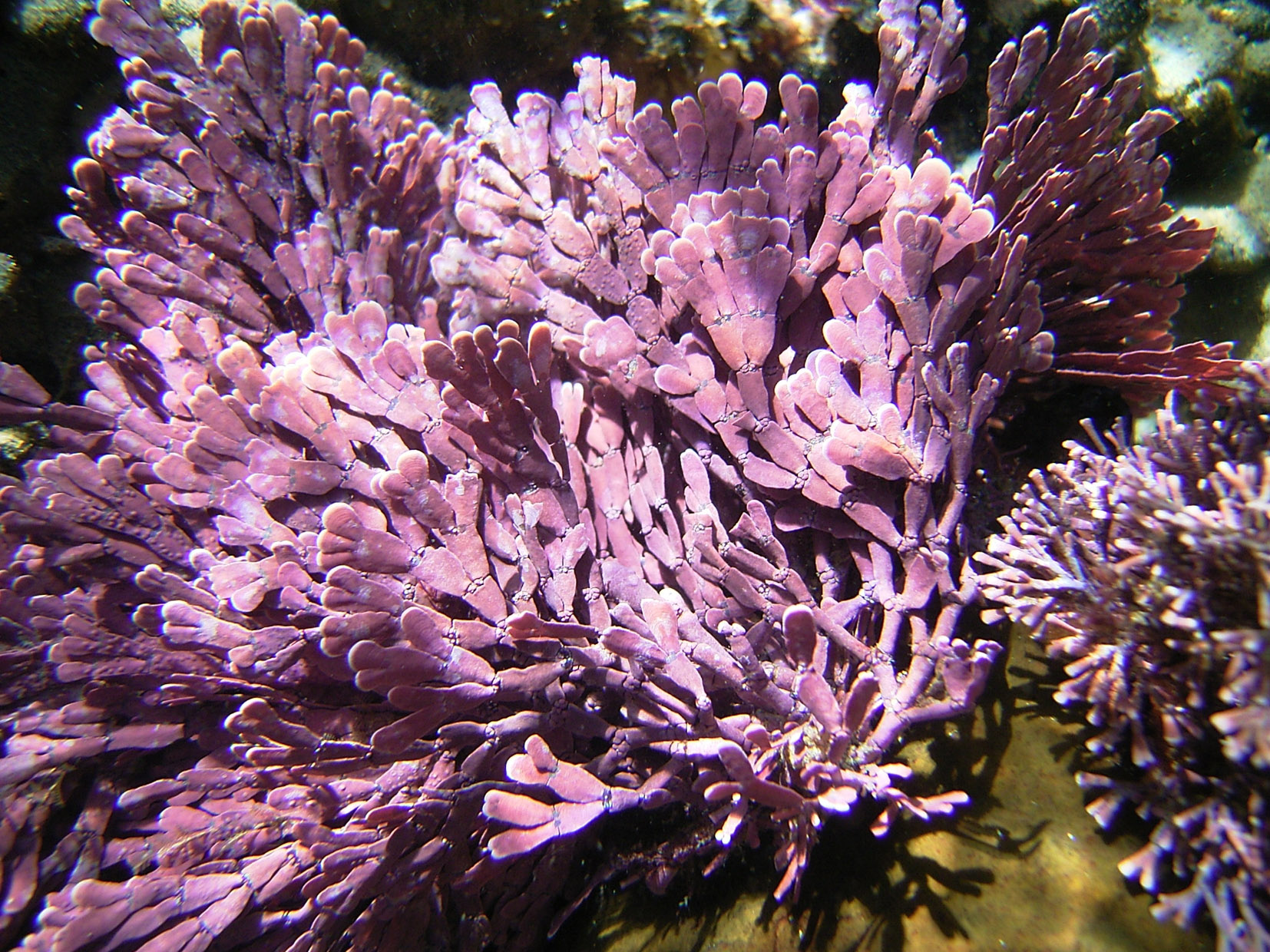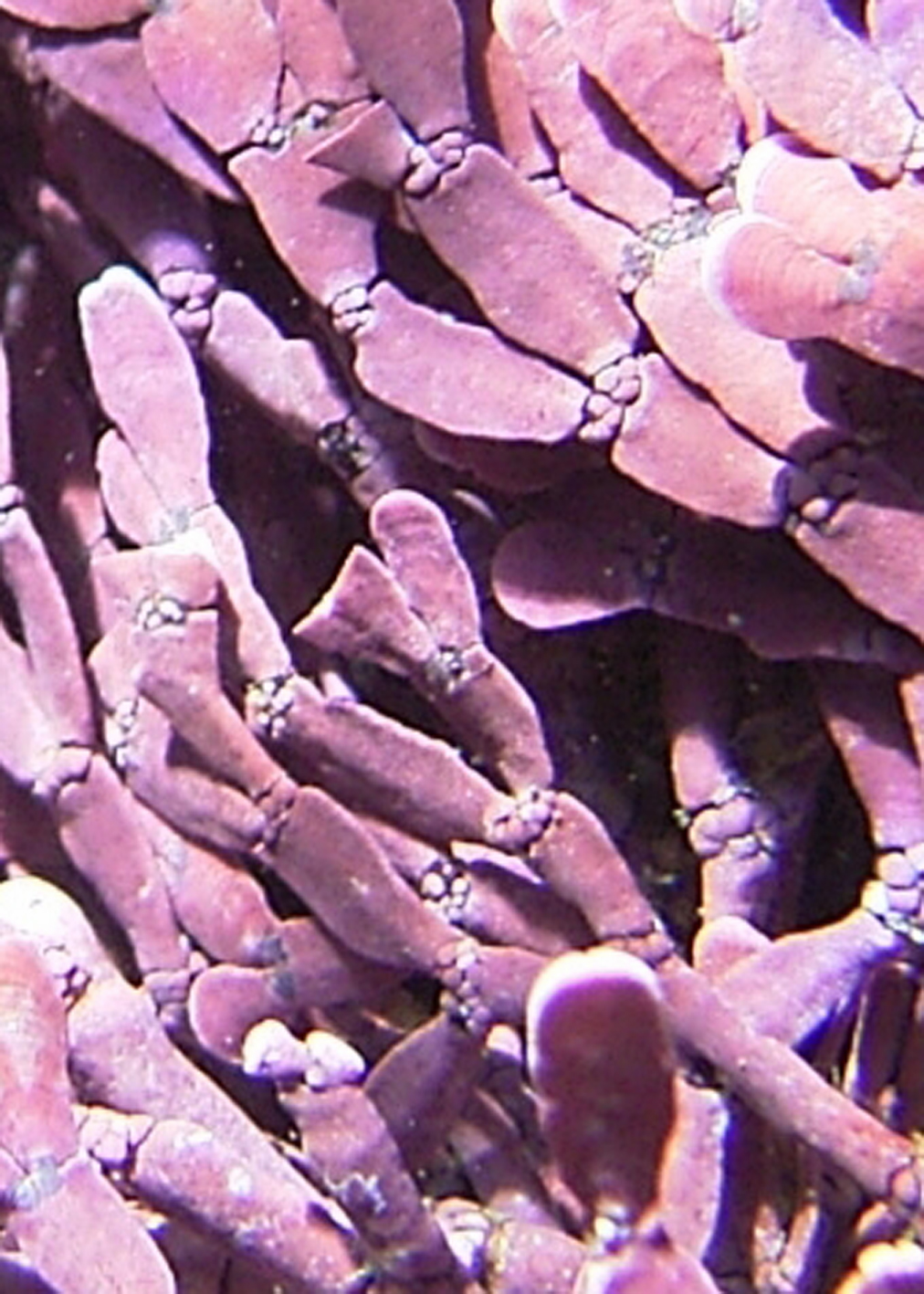Seaweeds of the South African South Coast


Order Corallinales
Family Corallinaceae
Sub-family Corallinoideae
Amphiroa bowerbankii Harvey 1849: 97, pl. 37 figs 1-6.
Plants up to 14 cm tall, pink to grayish-pink, forming dense, bushy tufts of broad, flat axes arising from crustose holdfast; axes flat with sharp edges, complanate, dichotomously to sometimes tri-or tetrachotomoulsy-branched. Genicula purplish, distinct, bearing small but conspicuous pink, calcified nodules; intergenicula flattened, rectangular, 5-8 mm long, 2-4 mm wide, apical segments with sharp, pale-white distal margins; branching at distal ends of almost all intergenicula and seldom from margins; shoulders of intergenicula sometimes extending beyond genicula. Reproductive structures in warty conceptacles on surfaces of intergenicula.
Collections, ecology and regional distribution
Epilithic in rock pools and from the lower eulittoral down to at least 28 m depth (De Clerck et al. 2005). Found from Stilbaai along the south and east coasts to Mabibi in northern KZN (26-57).
World distribution: Reported from Madagascar, Sri Lanka and Indonesia (Silva et al. 1996).
Type locality: Algoa Bay, Eastern Cape, South Africa (Guiry & Guiry 2014).
Note: Although Millar (1990) considered A. bowerbankii to be a synonym of A. anceps, De Clerck et al. (2005) noted that South African specimens of A. bowerbankii are broader than A. anceps and that the genicula of A. bowerbankii bear “prominent calcified nodules”. These differences are supported by the DNA barcoding study of Kogame et al. (2017), showing clear separation of these entities.

Amphiroa bowerbankii, Haga Haga.

Amphiroa bowerbankii, note calcified nodules on genicula.
References Amphiroa bowerbankii
De Clerck, O, Tronchin, E. M., Schils, T. 2005. Red algae. In: De Clerck, O., J.J.Bolton, R. J. Anderson and E. Coppejans, 2005. Guide to the Seaweeds of Kwazulu-Natal. National Botanic Garden of Belgium, Brussels (Scripta Botanica Belgica), pp. 130-269.
Guiry, M.D. & Guiry, G.M. 2014. AlgaeBase. World-wide electronic publication, National University of Ireland, Galway. http://www.algaebase.org; searched May 2014.
Harvey, W.H. (1849). Nereis australis, or algae of the southern ocean: being figures and descriptions of marine plants, collected on the shores of the Cape of Good Hope, the extra-tropical Australian colonies, Tasmania, New Zealand, and the Antarctic regions; deposited in the Herbarium of the Dublin University. Part 2. pp. 65-124, Plates XXVI-L. London: Reeve Brothers.
Kogame, K., Uwai, S., Anderson, R.J., Choi, H-G. & J.J. Bolton. 2017. DNA barcoding of South African geniculate coralline red algae (Corallinales, Rhodophyta). South African Journal of Botany 108: 337-341.
Millar, A.J.K. 1990. Marine red algae of the Coffs Harbour region, northern New South Wales. Australian Systematic Botany 3: 293-593, 76 figs, 2 tables.
Silva, P.C., Basson, P.W. & Moe, R.L. 1996. Catalogue of the benthic marine algae of the Indian Ocean. University of California Publications in Botany 79: 1-1259.
Cite this record as:
Anderson RJ, Stegenga H, Bolton JJ. 2016. Seaweeds of the South African South Coast.
World Wide Web electronic publication, University of Cape Town, http://southafrseaweeds.uct.ac.za; Accessed on 07 December 2025.